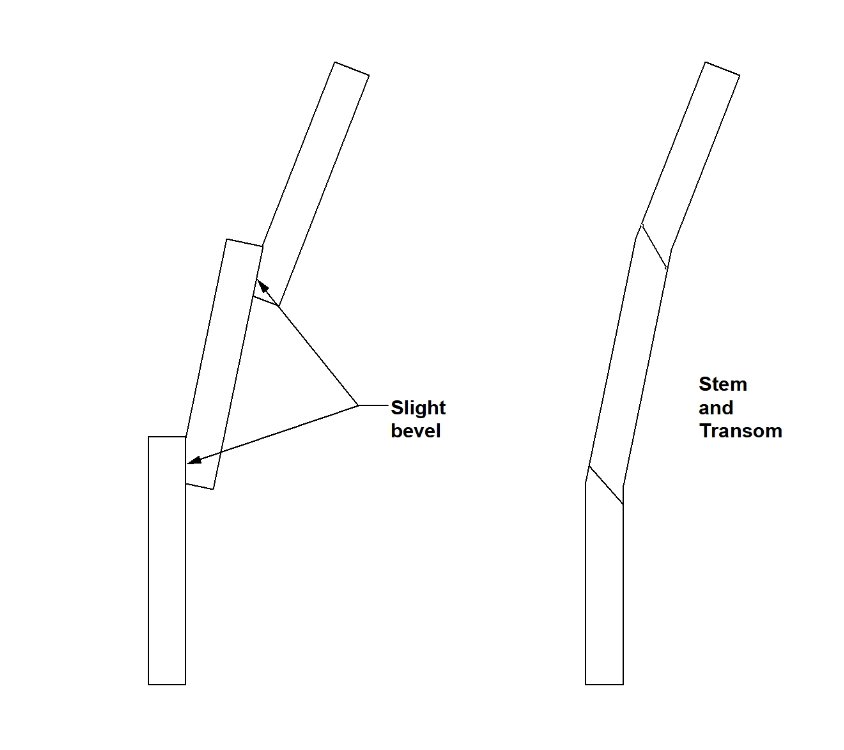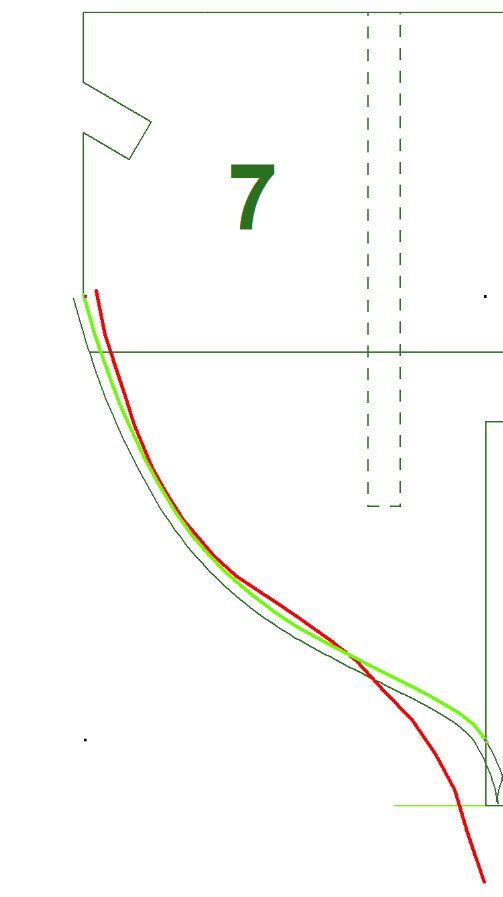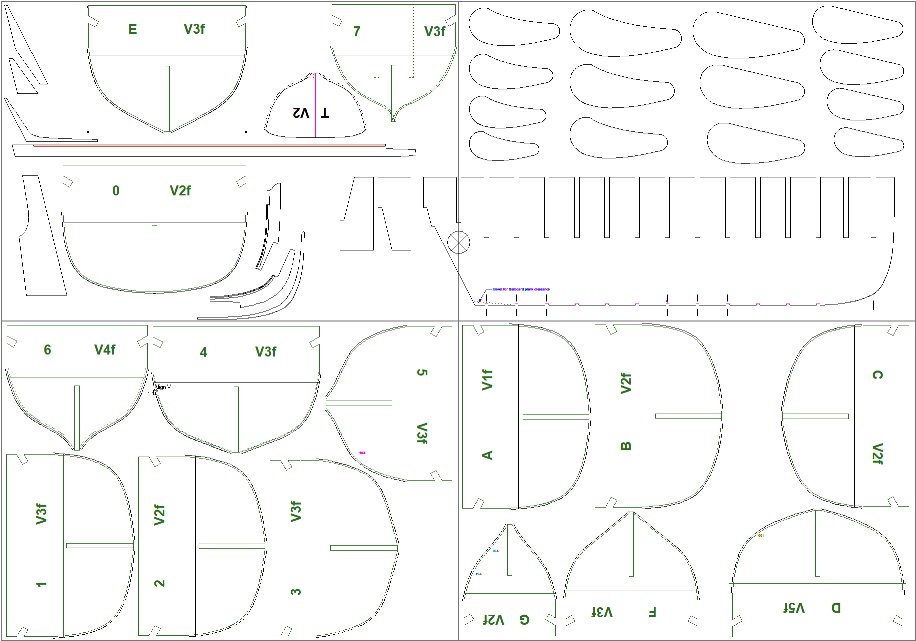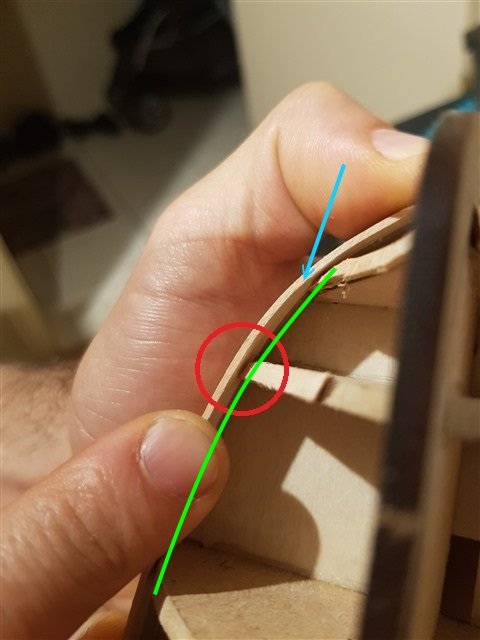-
Posts
967 -
Joined
-
Last visited
Content Type
Profiles
Forums
Gallery
Events
Everything posted by iMustBeCrazy
-
Work continues: The remaining planks are being spiled, that is shaped to the curve of the previous plank by measuring and cutting. It's a bit tedious. 1/ Scotch Magic tape is placed along the previous strake. 2/ Pencil marks are made of the edge of the previous strake at each station, transom and stem. 3/ The tape is removed and stuck on to a print of a homemade grid. 4/ The locations on the grid are transferred to the same grid in CAD. 5/ Adjustments are made allowing fore the strake overlap, 5/8th inch at the ends and 1 inch for the rest. 6/ A curve is drawn joining these points. 7/ Three new points are added below this curve at the transom, station 0 and the stem for the calculated width of the strake at those points. 8/ A curve is drawn joining these points. 9/ This is printed, cut out and test fitted to the previous strake (if it's not right start again Note in the pic that 4a (blue) has a kink at the red arrow and was rejected). 10/ Scotch Magic tape is placed on the board (sanded both sides) board stock and the printed strake is glued to the tape (the tape removes cleanly and the same printed strake can be use for the other side) 11/ The plank is cut to the share of the printed strake. Mark station 0 in some fashion. NOTE: The strakes are longer than the paper (A4) so continue the curves a bit further. 12/ Ditto for the other side. 13/ Both planks are stained and primed (interior side) with diluted PVA. 14/ Fit to the hull (sounds easy doesn't it).
-
Progress is mostly in the right direction, but much much slower than with balsa and CA. Didn't use enough glue in places but that's being fixed. Broke one rib which would have been less of a problem if I didn't run over it with my chair before I noticed. Lucky I had a spare. The interior is being stained prior to each strake being fitted, the exterior will be stained properly later. I slapped some paint on the balsa version just for the heck of it:
-
The test fitting showed a few of the moulds needed sanding so the the ribs didn't protrude above the false keel so that's been done, the ribs (except 6,7, F and G) have been glued to the moulds at their ends and to the keel. Ribs 6 and 7 will need to be glued to the keel first and then the moulds after that has dried. Moulds F and G have been made with false ribs and cant ribs will be fitted after the hull is remover from the jig. The cling film will stop me gluing the hull to the jig and hasn't caused any problems - yet, I will probably have to slit it between the moulds at some time to make clamping easier.
-
Progress continues, all the moulds have been tweaked in CAD, printed, glued to MDF and roughly cut out so I am / will be building what I hope is the final jig. The material for the ribs has been sanded on all four sides and the corners have been rounded off. They have also been stained (with a spirit based stain), steamed and bent or broken over the moulds of jig one ( yes I made spares). I haven't yet painted them with diluted PVA as I was thinking they may stick to the jig, but I was also thinking of covering the jig with cling film to stop the boat from sticking to the jig so I will probably paint the ribs anyway.
-
Allen, there is a very slight bevel the full length (or there is supposed to be), just enough so the overlaps sit together, then for about a foot each end there is a tapered or increasing 45 degree* bevel giving a carvel like join at the stem and transom but with 45 degree* edges. I still need more practice at that bit. * Nominal.
-
I knew I'd jinx myself, strake 6 (counting the garboard as 1) needs a little tweaking, about 3/8" (full scale) on four moulds. Not much but worth fixing. Meanwhile, I have been positioning the strakes with a 1" overlap using pins but I won't want to do this with the real model. So I am now using spacers from the keel (under the outer rubber bands in pic 1). These will be best pre-bent so I'm using scrap moulds to do this (pic 2), lucky I made them. I'm also using a scrap mould to pre-bend a strake (pic 3) the balsa is a bit brittle otherwise.
-
Well, planking in Balsa is paying off right from the beginning. I fitted the garboard planks and it pulls away from the keel at the stern (1) due to the bending. I suspect I will have to trim them as per (2) as I doubt I can edge set over such a short distance. The next plank needs edge setting (3) to keep the overlap and to allow for the bevel. This bevel starts out almost flat and twists round to 45 degrees at the end. Both planks are beveled. And yes, I know I cut the end of the garboard plank at the wrong angle, or is it the result of (1). I played around with the beveling needed to get the planks flush at the stern (and stem).
-
Thanks Allan, glad you popped in. ZAZ7361, the other Bounty launch, did you watch the video I posted in your 23 foot launch plans thread? 1:48 eek! Your planking will be just under 0.5mm thick, you'll almost be able to use shavings from a plane. Holly would be nice, Australia just doesn't have good modelling wood except Huon Pine, possibly the king of woods. I have some but the thought of the wastage milling small timbers is terrifying. In this model, which is largely an experiment, I'm using an Indonesian wood called Paulownia which has become available in small quantities at our largest hardware chain. It's about as dense as Basswood but more fibrous and has a stronger grain. So far it's not too bad. Meanwhile, I think I'll fully plank the current jig in Balsa in an attempt to avoid too many silly mistakes.
-
Well that went better than expected I glued two steel rulers together with a 2mm offset, added some 600 grit sandpaper to the underside, made up a cutting board with a straight backstop, sandwiched the stock between the rulers and the backstop and used several light strokes with a scalpel to cut each piece. Nice clean cuts so no need for finishing the edges. Speaking of finishing, it should be remembered that most of the inside of an open boat will be visible so pre-finishing exposed parts is advised if possible. The wood for the ribs was sanded before cutting and the ribs will be stained with a spirit based stain and coated with diluted PVA glue with a final very light sand prior to starting the build. The planking will be likewise finished on the inside. I have done a test and gluing is still fine, I haven't tested paint but I suspect acrylic paint will be fine too.
-
Well, I think six more moulds does it (but that included two that I sanded to the wrong line). The process for making the moulds is: 1/ Draw or edit in CAD 2/ Print 3/ Cut out roughly (except the straight edge which I cut with a ruler and scalpel) including the rubber band notches but not the slot for the false keel. 4/ Glue to a piece of MDF using a straight piece of wood (I use the fence on the band saw) to align the straight edge from step 3 with the edge of the MDF. I use a glue stick for this. 5/ Cut out roughly on the band saw 6/ Sand to shape on the disc sander beveling the edge at the same time. 7/ Back to the band saw and cut the slot for the false keel. (This is filed out later for a slightly firm fit on an offcut of MDF) I think the next step is to make a new set of moulds without the false ribs. And a new transom and probably a new keel/stem and stern post. (basically start from scratch). I also shaped and steam bent the forward end of one garboard plank, I then stuck on a post-it and trimmed it to size/shape and used it for a template for the other garboard plank. Having no mini table saw making planks is a pain. I cut them oversize on the bandsaw cleaning up the edge of the piece I am cutting from on some sandpaper on a flat board after each cut. Then sand them to size on the drill press. Then I have to make some ribs, 1mm x 2mm is going to be a pain.
-
Welcome all to my - First build log, first scratch build and first clinker/lapstrake build. It's a little scary. Ok, a 16ft cutter based on ZAZ7027 in 1:16 as a stable mate to the Model Shipways Bounty's Launch. This drawing has problems......... Trying to overcome those problems in CAD was beyond me so construction/trial and error was the next choice. Construction is similar to Bounty's Launch, ribs over a jig of a false keel and moulds. First I drew up and made the false keel then I drew up and made the moulds as per ZAZ7027 with the odd numbered drawn as halfway between those shown in the drawing. These were assembled with a friction fit and initial fairing began. This was done with a thin batten (1x2mm) as is traditional, errors were guestimated, corrected in CAD and a new mould was made (actually over 20 new moulds so far). I also drew and cut the keel, stem and sternpost. I did a trial fit of a garboard plank and realised it would be easier for the planking trials if I incorporated the ribs in the moulds, so a new set of moulds was made (that's about 50 moulds total now). Fairing continues but I'm taking a break and starting this log. I have incorporated a few things to make building easier such as the knotches for rubber bands for clamping, does anyone have any other suggestions?
-
G'day Mango, Probably. First I suggest you watch videos 24, 25, 78 and 85 at https://sampsonboat.co.uk/ They will give you some idea about fairing, setting out and planking. They are not tutorials but you do get explanations. Edge bending is about shrinking one edge of your piece of timber (you can't stretch it). In the picture the green line is a shorter distance than the distance along the adjoining strake so you need to shrink the the edge indicated (blue arrow), that is it needs to be on the inside of your bend.
-

48th Scale imperial rulers. Where?
iMustBeCrazy replied to John Murray's topic in Modeling tools and Workshop Equipment
The Excel 55777 fits the bill but for most of it's length it's resolution is 3 inches. That one seems to be Metric only, the only one I can be sure of is the Tankraft Imperial Pro Modeler Scale Ruler. @John Murray -

48th Scale imperial rulers. Where?
iMustBeCrazy replied to John Murray's topic in Modeling tools and Workshop Equipment
G'day John, best I can offer is that I posted a PDF with some scale rules I worked up in CAD. It prints to scale on my laser printer but you may have to make some adjustments when printing. After printing I just put Scotch Magic tape each side then trim to size. LINK -
I painted mainly because the strakes in the kit were in two very different colours and I just didn't like it. And yes the paint does bring out the imperfections, I may go back and make a curved sanding block that fits between the ribs and polish it up a bit. I do like a 'factory fresh' look so I might paint again. Next time I might play with pre-finishing the inside of the strakes, perhaps with diluted wood glue (after staining if that is the desired look) so they can still be glued to the ribs/frames. Just a thought.
-
My choice (on my Bounty Launch) was to set the riser and thwarts as per the drawing and raise the footwaling? (floorboards) as you are. As you can see in the pic my first try, which felt right, was too low and I had to add some more. I finished up with about 43cm in the real world.
-
And leaving stuff out because every shipwright knows how it's done....... Oh my aching head.
About us
Modelshipworld - Advancing Ship Modeling through Research
SSL Secured
Your security is important for us so this Website is SSL-Secured
NRG Mailing Address
Nautical Research Guild
237 South Lincoln Street
Westmont IL, 60559-1917
Model Ship World ® and the MSW logo are Registered Trademarks, and belong to the Nautical Research Guild (United States Patent and Trademark Office: No. 6,929,264 & No. 6,929,274, registered Dec. 20, 2022)
Helpful Links
About the NRG
If you enjoy building ship models that are historically accurate as well as beautiful, then The Nautical Research Guild (NRG) is just right for you.
The Guild is a non-profit educational organization whose mission is to “Advance Ship Modeling Through Research”. We provide support to our members in their efforts to raise the quality of their model ships.
The Nautical Research Guild has published our world-renowned quarterly magazine, The Nautical Research Journal, since 1955. The pages of the Journal are full of articles by accomplished ship modelers who show you how they create those exquisite details on their models, and by maritime historians who show you the correct details to build. The Journal is available in both print and digital editions. Go to the NRG web site (www.thenrg.org) to download a complimentary digital copy of the Journal. The NRG also publishes plan sets, books and compilations of back issues of the Journal and the former Ships in Scale and Model Ship Builder magazines.









